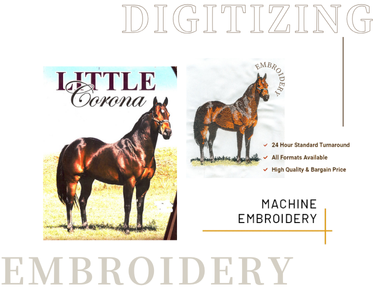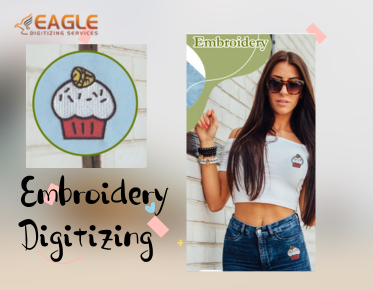How to use embroidery designs properly on cloth?
Embroidery is a craft that thrives on precision and passion, offering endless possibilities for expression. Whether you're creating personalized gifts, customizing apparel, or crafting intricate decorative pieces, the journey of mastering the art of embroidery is one of continual learning and growth. With every project, you refine your skills, discover new techniques, and gain a deeper understanding of how to turn simple fabric into an extraordinary work of art. For the best embroidery digitizing service, please feel free to contact us.
While mastering the basics is crucial, remember that embroidery is also about creativity and personal flair. The beauty of embroidery lies not just in following the rules but in experimenting with textures, colors, and design placements to make each piece unique. Don’t hesitate to challenge yourself with more complex designs or new fabric types, and always approach each project with a spirit of curiosity and joy. After all, every stitch you make brings you one step closer to becoming a true embroidery artist.
So, as you continue to explore this delightful craft, keep honing your skills, trust in your creativity, and embrace the process. Whether you're stitching a small, delicate motif or creating a bold, intricate masterpiece, the satisfaction of completing a project is incomparable. With practice and dedication, the world of embroidery will open up to you, offering limitless opportunities to make your fabric creations as beautiful and intricate as you imagine.
Unlocking the Secrets of Beautiful Embroidery
Embroidery is more than just a method of decorating fabric; it’s an art form, a way to transform a simple piece of cloth into something uniquely yours. The delicate balance between creativity, technique, and precision can take a basic design and elevate it to something extraordinary. Yet, as enchanting as it may seem, the true beauty of embroidery lies not only in the design but in how it’s applied to the fabric. The magic happens when every stitch, every color, and every placement is done with care. Whether you're a novice or a seasoned pro, understanding the nuances of how to properly use embroidery designs on cloth is the first step toward achieving flawless, professional results.
Choosing the Right Fabric for Your Embroidery Design
Selecting the ideal fabric for your embroidery design is a critical factor in determining how well the design will come to life. Different fabrics have varying textures, weights, and levels of stretch, and these characteristics influence how the stitches will appear. For example, lightweight fabrics like cotton or linen are excellent for intricate, fine designs, while heavier fabrics such as denim or canvas offer durability for bolder, more prominent patterns. Choosing the right fabric ensures that the design will hold up well under stitching pressure, without warping or distorting. However, delicate fabrics such as silk or tulle require extra attention—they may be prone to puckering or snagging if not handled correctly. Knowing which fabrics pair best with your design style is the foundation for creating beautiful embroidered pieces.
Preparing Your Fabric for Embroidery
Before diving into the stitching process, proper fabric preparation is essential. Pre-washing is the first step you should never skip. Washing your fabric before embroidery prevents any shrinkage issues after the stitching is complete. It also ensures that the fabric is free from any chemicals or sizing agents that could interfere with your threads. Once the fabric is clean and dry, the next crucial step is stabilizing it. A stabilizer provides support, preventing the fabric from shifting, stretching, or puckering during stitching. Choosing the right stabilizer depends on the fabric type—tear-away, cut-away, or water-soluble stabilizers all serve different purposes. Finally, cutting the fabric to the correct size is crucial. Precision is key—too much fabric can make hooping challenging, and too little fabric may cause the design to fall off-center. Taking time to properly prepare your fabric ensures that your embroidery process will be smooth and successful.
Understanding Different Types of Embroidery Designs
Not all embroidery designs are created equal, and understanding the types is important for choosing the right technique. Flat embroidery is ideal for designs that are best seen from a single angle—think logos, text, or geometric patterns. The design is sewn directly onto the fabric without significant height or dimension. On the other hand, raised embroidery, also known as 3D embroidery, adds texture and depth, making it perfect for designs that need to stand out. This technique often uses foam, felt, or other materials beneath the stitches to create volume and a tactile quality. The type of design you’re working with dictates the embroidery technique you’ll choose, as well as the fabric you’ll use. Selecting the right design type helps ensure that the final product matches your vision.
The Importance of Proper Hoop Placement
Hooping is a vital step in the embroidery process that can make or break the quality of your design. A properly hooped fabric ensures that it stays taut and secure throughout the stitching process. If the fabric is loose in the hoop, it can shift or gather, resulting in uneven stitching and a distorted design. Additionally, positioning the design within the hoop is crucial for a balanced and symmetrical result. Centering your design helps maintain its alignment and ensures that the design stays within the intended boundaries. While hooping may seem simple, small adjustments, such as ensuring the fabric is even and taut, can make a significant difference in the quality of your finished project.
Choosing the Right Needle and Thread for Your Design
The right needle and thread combination plays a huge role in the final look of your embroidery. Needles come in different sizes and types, each suited to specific fabrics and thread thicknesses. For instance, a ballpoint needle works well for stretchy fabrics, while a sharp needle is better for woven textiles. Similarly, the choice of thread can dramatically affect the texture and appearance of your design. High-quality threads, like polyester or rayon, offer a vibrant, long-lasting finish. The weight and thickness of the thread should match the fabric and design size, ensuring that the stitches are neither too bulky nor too fine. Furthermore, the color of the thread needs to be chosen carefully to complement the fabric and overall aesthetic of the design. Understanding how to combine the right needle and thread with your fabric makes all the difference between an ordinary and an extraordinary embroidered project.
Positioning and Aligning Your Embroidery Design on Cloth
Positioning your design accurately is a critical step in achieving a polished look. When the design is off-center or misaligned, the whole piece can appear unprofessional. Using guides, grids, or even simple measurements can help you place your design exactly where you want it. Marking the center of your fabric and your design allows for perfect alignment, which is especially important for designs with symmetrical elements. Keeping the design balanced ensures that it doesn’t pull the fabric unevenly during stitching, which could result in distortion or puckering. Taking the time to position and align your design precisely is an essential practice for achieving a flawless embroidered piece.
Techniques for Transferring Embroidery Designs onto Fabric
Transferring your embroidery design onto fabric can be done in various ways, and choosing the right method depends on the complexity and type of design. Tracing is a common technique, especially for simple, hand-drawn designs. You can trace the design directly onto the fabric using a washable fabric marker or chalk. Alternatively, printing designs onto transfer paper is an option, particularly for more intricate or detailed work. Once printed, the design can be transferred onto the fabric with heat or pressure. Using stabilizers during the transfer process adds extra security, ensuring that the fabric doesn’t shift or stretch during the transfer and that the design remains crisp and clear.
Stitching Your Design: Tips for Success
When it comes to stitching, each step requires attention to detail. Choosing the right stitch type for each section of your design is crucial—some areas may benefit from a satin stitch, while others might require a fill stitch for more coverage. Consistent tension is also important to ensure that the stitches lie flat against the fabric and don’t pull or create puckers. Managing stitch density is another aspect to consider. Too many stitches in one area can cause the fabric to stiffen, while too few can make the design look sparse. Understanding how to control these elements allows you to create a clean, professional design that flows smoothly across the fabric.
Troubleshooting Common Issues While Embroidering on Fabric
Embroidery is not without its challenges, and knowing how to handle common issues can save you a lot of frustration. One of the most common problems is puckering, where the fabric bunches up around the stitches. This can often be avoided by properly stabilizing the fabric or adjusting the tension. Thread breaks are another headache, usually caused by incorrect thread tension or a damaged needle. Uneven stitch placement is another frequent issue, often resulting from improper hooping or inaccurate alignment. Troubleshooting these problems early on can prevent mistakes from escalating and help you create a perfect embroidered piece.
Finishing Touches: Caring for Your Embroidered Fabric
After the stitching is complete, the final touches are essential for ensuring your design lasts. Removing the stabilizer carefully ensures that it doesn’t damage your embroidery or fabric. Pressing and ironing the embroidered fabric with caution helps to smooth out any wrinkles and flatten the stitches without causing them to distort. It's important to use the proper heat settings and avoid pressing directly on the design. Lastly, storing your embroidered fabric properly ensures its longevity—keeping it away from direct sunlight and moisture will preserve the colors and prevent any damage to the stitches.
Mastering the Art of Embroidery on Cloth
Embroidery on fabric is a process that combines creativity, technique, and patience. By understanding how to properly choose fabrics, stabilize your materials, and carefully execute each stitch, you can elevate your embroidery to new heights. The satisfaction of seeing a design come to life on fabric, especially when everything is aligned perfectly, is incredibly rewarding. Keep experimenting with different techniques and refining your skills, and soon enough, your embroidery designs will be something to truly admire.
By understanding how to properly choose fabrics, stabilize your materials, and carefully execute each stitch, you can elevate your embroidery to new heights. Fabric choice plays a pivotal role in the outcome of your design, influencing everything from stitch definition to the overall texture. Stabilizing your fabric ensures that the design remains crisp and clear, even after multiple washes. Understanding the nuances of fabric types, stabilizers, and hooping methods is key to producing designs that stand the test of time, whether they are on delicate silk or sturdy denim. Eagle Digitizing offers embroidery digitizing services.


.png)
